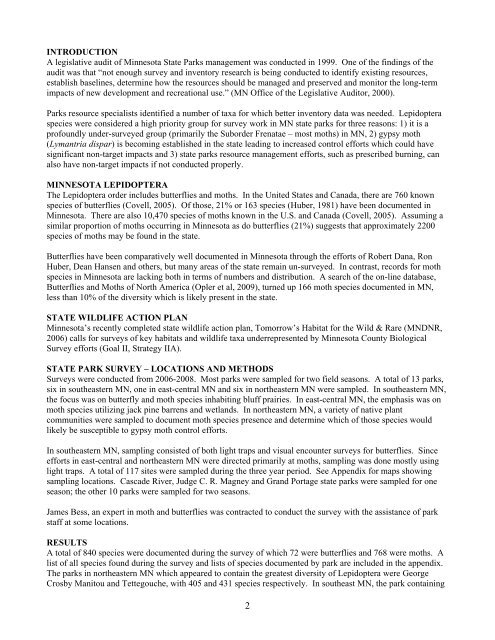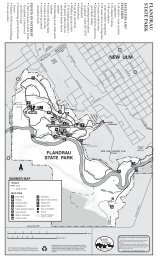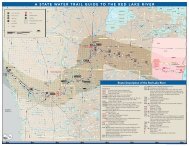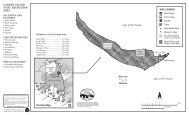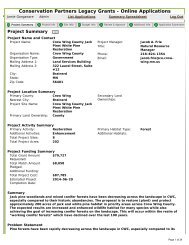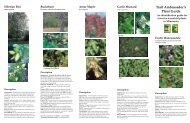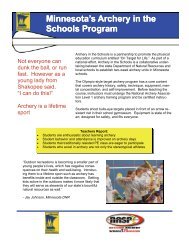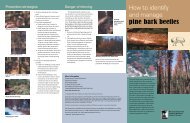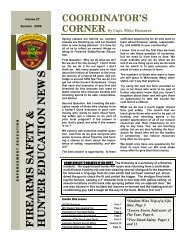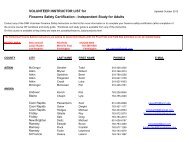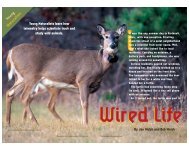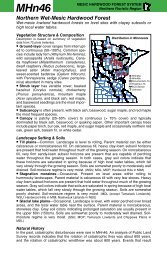A survey of Lepidoptera in three priority areas of the Minnesota state ...
A survey of Lepidoptera in three priority areas of the Minnesota state ...
A survey of Lepidoptera in three priority areas of the Minnesota state ...
Create successful ePaper yourself
Turn your PDF publications into a flip-book with our unique Google optimized e-Paper software.
INTRODUCTION<br />
A legislative audit <strong>of</strong> M<strong>in</strong>nesota State Parks management was conducted <strong>in</strong> 1999. One <strong>of</strong> <strong>the</strong> f<strong>in</strong>d<strong>in</strong>gs <strong>of</strong> <strong>the</strong><br />
audit was that “not enough <strong>survey</strong> and <strong>in</strong>ventory research is be<strong>in</strong>g conducted to identify exist<strong>in</strong>g resources,<br />
establish basel<strong>in</strong>es, determ<strong>in</strong>e how <strong>the</strong> resources should be managed and preserved and monitor <strong>the</strong> long-term<br />
impacts <strong>of</strong> new development and recreational use.” (MN Office <strong>of</strong> <strong>the</strong> Legislative Auditor, 2000).<br />
Parks resource specialists identified a number <strong>of</strong> taxa for which better <strong>in</strong>ventory data was needed. <strong>Lepidoptera</strong><br />
species were considered a high <strong>priority</strong> group for <strong>survey</strong> work <strong>in</strong> MN <strong>state</strong> parks for <strong>three</strong> reasons: 1) it is a<br />
pr<strong>of</strong>oundly under-<strong>survey</strong>ed group (primarily <strong>the</strong> Suborder Frenatae – most moths) <strong>in</strong> MN, 2) gypsy moth<br />
(Lymantria dispar) is becom<strong>in</strong>g established <strong>in</strong> <strong>the</strong> <strong>state</strong> lead<strong>in</strong>g to <strong>in</strong>creased control efforts which could have<br />
significant non-target impacts and 3) <strong>state</strong> parks resource management efforts, such as prescribed burn<strong>in</strong>g, can<br />
also have non-target impacts if not conducted properly.<br />
MINNESOTA LEPIDOPTERA<br />
The <strong>Lepidoptera</strong> order <strong>in</strong>cludes butterflies and moths. In <strong>the</strong> United States and Canada, <strong>the</strong>re are 760 known<br />
species <strong>of</strong> butterflies (Covell, 2005). Of those, 21% or 163 species (Huber, 1981) have been documented <strong>in</strong><br />
M<strong>in</strong>nesota. There are also 10,470 species <strong>of</strong> moths known <strong>in</strong> <strong>the</strong> U.S. and Canada (Covell, 2005). Assum<strong>in</strong>g a<br />
similar proportion <strong>of</strong> moths occurr<strong>in</strong>g <strong>in</strong> M<strong>in</strong>nesota as do butterflies (21%) suggests that approximately 2200<br />
species <strong>of</strong> moths may be found <strong>in</strong> <strong>the</strong> <strong>state</strong>.<br />
Butterflies have been comparatively well documented <strong>in</strong> M<strong>in</strong>nesota through <strong>the</strong> efforts <strong>of</strong> Robert Dana, Ron<br />
Huber, Dean Hansen and o<strong>the</strong>rs, but many <strong>areas</strong> <strong>of</strong> <strong>the</strong> <strong>state</strong> rema<strong>in</strong> un-<strong>survey</strong>ed. In contrast, records for moth<br />
species <strong>in</strong> M<strong>in</strong>nesota are lack<strong>in</strong>g both <strong>in</strong> terms <strong>of</strong> numbers and distribution. A search <strong>of</strong> <strong>the</strong> on-l<strong>in</strong>e database,<br />
Butterflies and Moths <strong>of</strong> North America (Opler et al, 2009), turned up 166 moth species documented <strong>in</strong> MN,<br />
less than 10% <strong>of</strong> <strong>the</strong> diversity which is likely present <strong>in</strong> <strong>the</strong> <strong>state</strong>.<br />
STATE WILDLIFE ACTION PLAN<br />
M<strong>in</strong>nesota’s recently completed <strong>state</strong> wildlife action plan, Tomorrow’s Habitat for <strong>the</strong> Wild & Rare (MNDNR,<br />
2006) calls for <strong>survey</strong>s <strong>of</strong> key habitats and wildlife taxa underrepresented by M<strong>in</strong>nesota County Biological<br />
Survey efforts (Goal II, Strategy IIA).<br />
STATE PARK SURVEY – LOCATIONS AND METHODS<br />
Surveys were conducted from 2006-2008. Most parks were sampled for two field seasons. A total <strong>of</strong> 13 parks,<br />
six <strong>in</strong> sou<strong>the</strong>astern MN, one <strong>in</strong> east-central MN and six <strong>in</strong> nor<strong>the</strong>astern MN were sampled. In sou<strong>the</strong>astern MN,<br />
<strong>the</strong> focus was on butterfly and moth species <strong>in</strong>habit<strong>in</strong>g bluff prairies. In east-central MN, <strong>the</strong> emphasis was on<br />
moth species utiliz<strong>in</strong>g jack p<strong>in</strong>e barrens and wetlands. In nor<strong>the</strong>astern MN, a variety <strong>of</strong> native plant<br />
communities were sampled to document moth species presence and determ<strong>in</strong>e which <strong>of</strong> those species would<br />
likely be susceptible to gypsy moth control efforts.<br />
In sou<strong>the</strong>astern MN, sampl<strong>in</strong>g consisted <strong>of</strong> both light traps and visual encounter <strong>survey</strong>s for butterflies. S<strong>in</strong>ce<br />
efforts <strong>in</strong> east-central and nor<strong>the</strong>astern MN were directed primarily at moths, sampl<strong>in</strong>g was done mostly us<strong>in</strong>g<br />
light traps. A total <strong>of</strong> 117 sites were sampled dur<strong>in</strong>g <strong>the</strong> <strong>three</strong> year period. See Appendix for maps show<strong>in</strong>g<br />
sampl<strong>in</strong>g locations. Cascade River, Judge C. R. Magney and Grand Portage <strong>state</strong> parks were sampled for one<br />
season; <strong>the</strong> o<strong>the</strong>r 10 parks were sampled for two seasons.<br />
James Bess, an expert <strong>in</strong> moth and butterflies was contracted to conduct <strong>the</strong> <strong>survey</strong> with <strong>the</strong> assistance <strong>of</strong> park<br />
staff at some locations.<br />
RESULTS<br />
A total <strong>of</strong> 840 species were documented dur<strong>in</strong>g <strong>the</strong> <strong>survey</strong> <strong>of</strong> which 72 were butterflies and 768 were moths. A<br />
list <strong>of</strong> all species found dur<strong>in</strong>g <strong>the</strong> <strong>survey</strong> and lists <strong>of</strong> species documented by park are <strong>in</strong>cluded <strong>in</strong> <strong>the</strong> appendix.<br />
The parks <strong>in</strong> nor<strong>the</strong>astern MN which appeared to conta<strong>in</strong> <strong>the</strong> greatest diversity <strong>of</strong> <strong>Lepidoptera</strong> were George<br />
Crosby Manitou and Tettegouche, with 405 and 431 species respectively. In sou<strong>the</strong>ast MN, <strong>the</strong> park conta<strong>in</strong><strong>in</strong>g<br />
2


